It might look streamlined and understated, but the Pixel 9a is Google at its very best. It packs the right mix of features and flexibility with a simplified design that no longer picks up dust on its way in or out of your pocket. Pair that with long-term updates and a battery that goes and goes, and it’s hard to find another phone worth recommending as much as this one at the same $499 price.
Everyone loves a good flagship phone — they get the best cameras, the fastest charging, and the best materials that an (increasingly large) pile of money can buy. I’m no different. I love to keep a Pixel 9 Pro or an iPhone 16 in my pocket, and I try to spend a few months of the year with a foldable phone as my primary device. The rest of the time, though, I hop from one budget or mid-range phone to the next, trying to find out how much you can get without breaking the bank.
Sometimes, I’m let down by the experience, but other times, I am ready to recommend a cheaper phone to almost everyone who asks. This is one of those times. The Pixel 9a is Google at its best, and it’s the easiest mid-range phone to recommend in years, so long as you can live without a few things.
I love the reasoning behind Google’s simplified design
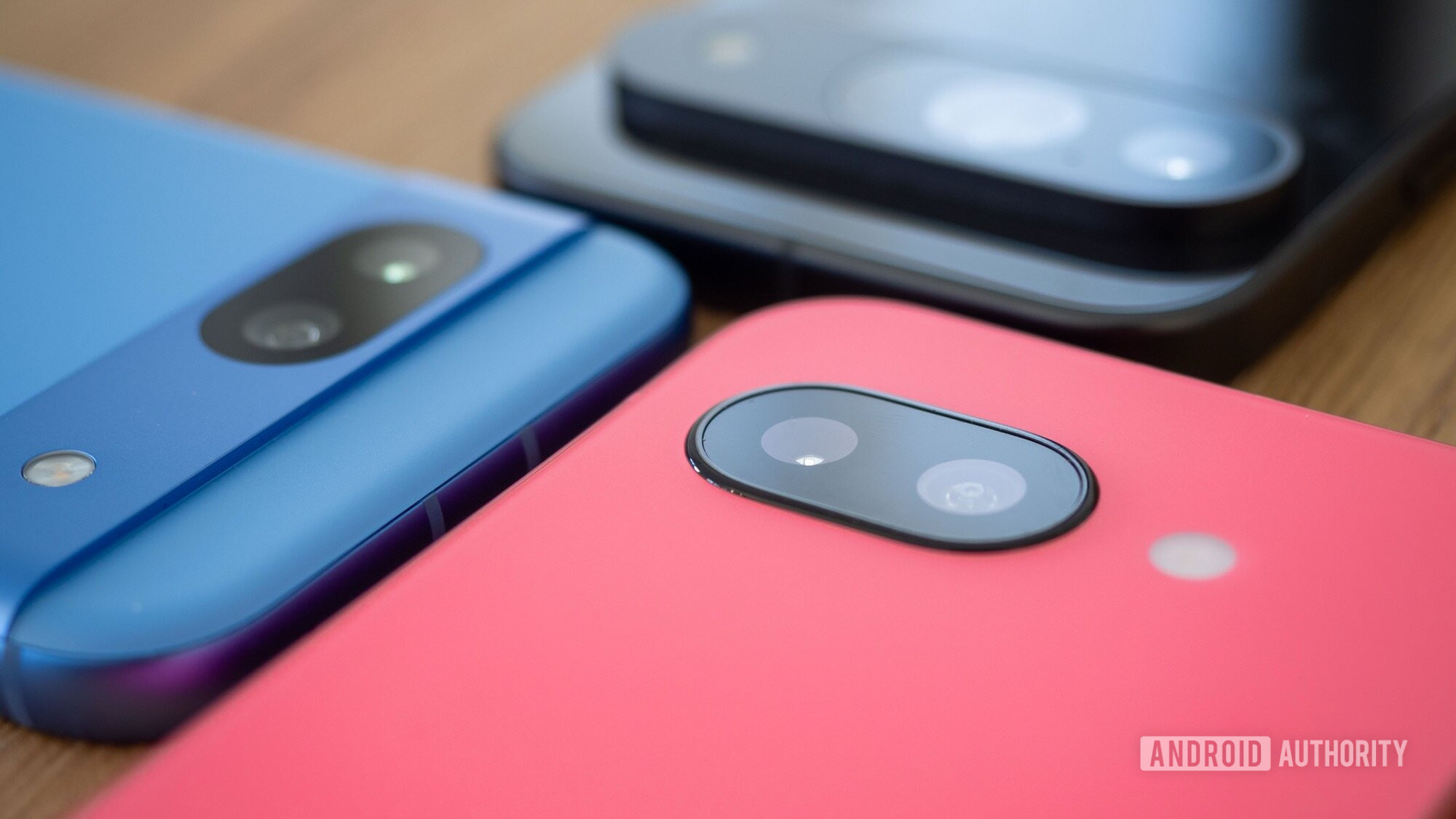
Rita El Khoury / Android Authority
Remember when I just (one sentence ago) said you’d have to live without a few things on the Pixel 9a? Well, the most recognizable one of those things is the lack of the camera bar. Yes, after four generations of Pixels with iconic visors protecting their camera sensors, this latest mid-ranger takes a decidedly subtle approach. And you know what? I kinda like it this way. I don’t know if I like it better, necessarily, but I do like it. In fact, I was surprised by how quickly the Pixel 9a’s design grew on me, but I think it helped that Google wasn’t just streamlining its style for the sake of it.
What I mean is this — Google didn’t set out to get rid of the camera bar when it started designing the Pixel 9a. It knows it has one of the more unique camera setups among Android phones, and it’s tough to walk away from that. However, by switching its pOLED panel to a thinner version, the Pixel team suddenly found itself with far more extra space inside the body of the Pixel 9a — space that it then filled with a combination of a much bigger battery (a full 5,100mAh) and a newly recessed camera bar.
Google’s clever method for ditching the camera bar easily won me over with the Pixel 9a’s new design.
The result of that change is a design that’s maybe a little bit less instantly recognizable, but also one that slides in and out of my pocket much easier than before. The lack of a camera bar also means there’s no abrupt edge to collect dust, and Google’s first-party silicone case doesn’t have to be nearly as thick to offer the same level of protection. Besides, I think the Pixel 9a is still easy to pick out as a Google device, even if the simpler parts of its design now have to do a bit more heavy lifting. Those simpler parts — the flat side rails, comfortably rounded corners, and vibrant finishes like Iris and Peony — all feel decidedly Google, even if the choice of materials doesn’t quite match the lofty standard of the Pixel 9 series. Of course, the Pixel 9a also comes in more subdued shades of Porcelain and Obsidian, but I have to say that my Iris version is the best of the bunch.
Of course, there was always going to be a downgrade in terms of toughness when coming to the Pixel A series. Google can’t pack every device in its lineup with Gorilla Glass Victus 2 all around, or it would be hard to separate the Pixel 9a from its sibling, the Pixel 9. As usual, Google swapped the rear glass for a matte plastic panel that resists fingerprints pretty nicely. It’s guarded by an aluminum frame and finished with a 6.3-inch display made of Gorilla Glass 3. If anything, that’s one of my larger disappointments with the Pixel 9a — Gorilla Glass 3 has been around for a decade now, so it’s probably time for Google to find something just a little bit tougher.
Thankfully, the pOLED panel that the Gorilla Glass 3 protects is good enough for me to ignore its durability, at least once I’ve wrapped my head around its slightly thicker bezels. Google decided to bump its display slightly, expanding from 6.1 inches to 6.3 and pairing it with a refresh rate that bounces between 60Hz and 120Hz depending on your needs. Google also cranked its peak brightness from 2,000 nits on the Pixel 8a to 2,700 on the Pixel 9a, which certainly came in handy while I took the phone as my primary companion for a wedding in Mexico. It was able to shine through levels of sunlight that I don’t think I’ve ever seen at home in Maryland, or, if I have, I’d forgotten about them through the gray of winter.
The Pixel 9a’s display isn’t just bright, though — it’s consistently sharp and smooth. I downloaded a couple of movies for my flights back and forth, and found myself reaching for Google’s smaller pOLED over the much larger LCD panel on the OnePlus Pad 2 that I’d also packed. Simply put, Google’s deeper blacks made it more enjoyable to watch a naturally lit film like Netflix’s The King (yes, I know I’m several years behind), and I much preferred the convenience of having my Pixel Buds A Series already paired.
Once I landed, the Pixel 9a’s bright display and beefed-up battery (more on that in a minute) continued to come in handy. I relied heavily on Google Maps to find my way around the airport in Cancun while trying to track down my cousin so that we could make our way to our Airbnb. Despite the unfamiliar environment and sudden need for roaming data, the Pixel 9a didn’t seem to blink, though it got a little warm in my hand, probably due to the 50-degree jump in temperature.
Other bits of the Pixel 9a’s design came in handy during my weekend away, too, like the IP68 rating, which gave me peace of mind against dust while sitting on a sandy beach, and the combination of an optical fingerprint reader and face unlock, which allowed me to get into my phone whether or not my hands were sandy. Granted, the Pixel 9a’s soft rubber case took less kindly to the sand or, as Anakin Skywalker would have put it, “it’s coarse and rough and irritating and it gets everywhere.” I don’t think a fabric case would have fixed that issue, but it won’t stop me from asking Google to bring them back.
The Pixel 9a’s new battery is a Tensor’s best friend
One of the most significant benefits of Google’s refreshed design is that massively upgraded battery — the largest you’ll find on any Pixel — but there’s much more to discuss under the hood. For starters, the Pixel 9a packs the latest Tensor G4 chipset to keep the light on, which aligns with its flagship siblings. It’s key to everything Google values about its Pixel devices, from long-term updates to clever camera features and all things Gemini. However, to keep the Pixel 9a from being too close to its relatives, Google again had to make some tweaks, such as a slightly downgraded modem and the resulting lack of SOS satellite connectivity, but perhaps most notably, the cutting of onboard RAM from 12GB to 8GB.
To find out just how big of a change that drop in RAM might be, I did what we always do: I put the Pixel 9a through the wringer. I figured it would probably continue to benchmark behind powerful chipsets like Apple’s A18, the same as Google’s Pixel 9 series had done, but I was curious to see how it fared against other Android foes like the previous Pixel 8a with its Tensor G3 and the Samsung Galaxy S24 FE with its Exynos 2400e. So, I ran the group through our usual CPU and GPU tests to see if Google’s performance claims held up.
Having reviewed Apple’s mid-range iPhone 16e not that long ago and come up with a dataset very similar to this one, I wasn’t surprised by the results above. Yes, the Tensor G4 puts up better numbers than its predecessor in the Pixel 8a, but it still falls behind both Apple’s and Samsung’s chipsets by a decent margin. The gap between the Tensor and the Exynos 2400e in the single-core Geekbench 6 test isn’t too large, but it opens quite a bit wider once you switch to multi-core workloads. Also, while the Pixel 9a may only have beaten its predecessor in our graphics-heavy Wild Life stress test, it showed less of a drop throughout 20 runs than either the iPhone 16e or the Galaxy S24 FE, which should be a good sign if you have eyes on gaming with Google’s mid-ranger. You can read a deeper dive into the Pixel 9a performance vs the Galaxy S24 FE and iPhone 16e at the link.
But, as we often say, controlled benchmarking performance only tells a small part of the story, especially when using a Pixel. While Google’s Tensor G4 might fall behind on paper, it’s a consistent performer in day-to-day life, and I had no problems trusting it at home and abroad. I packed it for my trip to Mexico alongside an ever-reliable iPhone 16 — just in case — but hardly found myself reaching for the more expensive device during my travels. Sure, I occasionally needed the iPhone for a quick FaceTime call to check on my cats, but the Pixel handled everything from finding restaurant recommendations to snapping photos during the wedding reception to quickly translating ingredient lists on snacks to avoid allergens.
It might benchmark behind Apple and Samsung, but the Pixel 9a’s Tensor G4 stands up to daily life without issue.
I’ll also admit that I didn’t have time to brush up on my Spanish skills before heading abroad (blame a busy spring), so I relied on the Pixel 9a for a lot of quick translation while asking for directions and trying to work out a few of the signs at the Mayan ruins in Tulum. In both cases, Google’s Tensor G4 handled what I asked for quickly and efficiently, leaving me feeling a bit less like a fish out of water.
However, just because the Pixel 9a does most of the things its flagship siblings can do doesn’t mean it checks all the boxes. The mid-ranger supports most of the updated, AI-infused Pixel standards like Pixel Weather, Pixel Studio, and access to Gemini Live, but Pixel Screenshots didn’t make the cut for some reason. I’m not sure what it is about Google’s searchable, well-organized screenshot manager that made it too intense for the Pixel 9a, but it’s just not here, and there’s no way to download it. I won’t pretend I used Pixel Screenshots a ton — it’s less valuable to me than Nothing’s Essential Space — but it’s a very strange app to skip over for this launch.
The rest of Google’s AI-powered features run smoothly on the Pixel 9a, though, with a couple of new wrinkles like Clear Voice making their way to the Recorder app, and the newly refreshed Pixel Studio allows you to generate images of people as needed. You still can’t add familiar (or famous) faces, but the overall experience feels much more complete.
Now that we’ve covered what the Tensor G4 chipset brings to the table, let’s talk battery life. As mentioned above, the Pixel 9a’s revamped design allowed the team to pack it with a massive 5,100mAh battery — larger than the cell in the Pixel 9 Pro XL — and boast that it could achieve 30-plus hours of battery life. Longtime Pixel fans might recognize that as a bump over the 24-plus hours that Google usually claims, so I was curious to see if there was any merit to that figure.
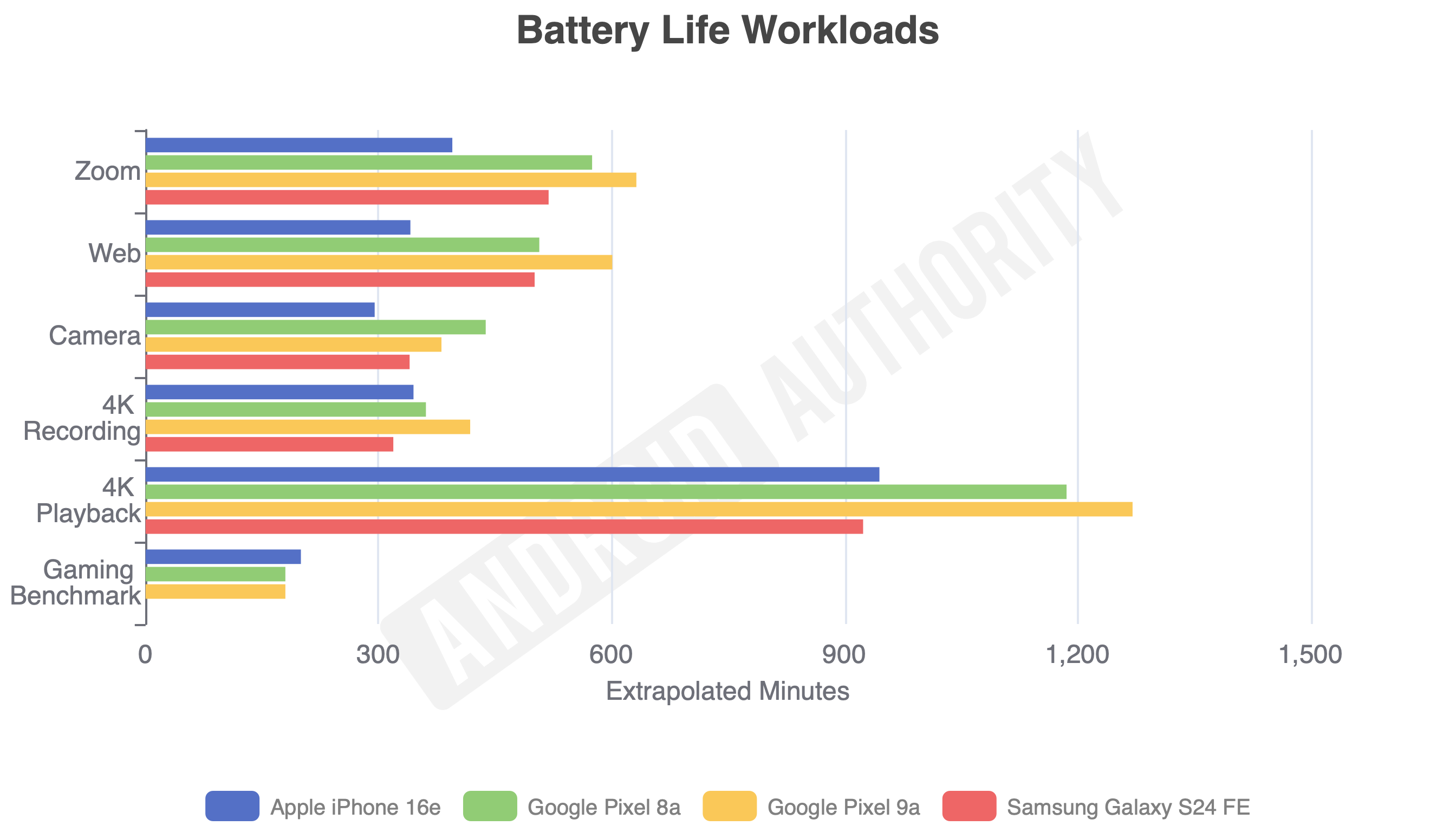
Ryan Haines / Android Authority
At first, I didn’t think there was — my initial runs through our standard battery test showed that the Pixel 9a was almost identical to the Pixel 9 and the Pixel 8a before it, despite their much smaller cells. Then, after having a bit more time to settle in with the mid-ranger, I reran the tests and found that the lab-controlled battery test performed much better. The Pixel 9a jumped from mid-pack to ahead of Google’s other offerings, knocking off both the iPhone 16e and Galaxy S24 FE along the way. Now, I felt it would tackle the former due to its roughly 4,000mAh battery despite Apple’s excellent optimization, but I was surprised to see the Pixel 9a jump the latter with its similarly sized cell.
Perhaps the real reason that my initial battery tests — the ones that didn’t go well — surprised me so much is because they never once mirrored my real-life experience. In using the Pixel 9a, I rarely felt that impending sense of battery anxiety within the first day of usage, as long as we’re not counting my travel day to Mexico, which started at 3:00 AM EDT and didn’t wrap up until about 11:00 PM EST, which does include a time change thanks to one country’s better view of daylight savings time (I’ll let you decide which one). On an average day, though, I spent plenty of time out and about, bouncing between maps, translation, and the occasional Spotify break when I needed to recharge my social battery, and had no issues. Even on camera-heavy days like my trip to the Mayan ruins, I could more than balance the Pixel 9a’s needs with my limited access to outlets.
Even the best of batteries run out, though, so eventually you’ll have to track down an outlet to get your Pixel 9a back up and running. When that happens, you’ll have to follow quite a few familiar rules, like having a USB PD PPS charger to reach peak speeds. Naturally, Google recommends its in-house Pixel charger, but there are plenty of similar options we recommend, including several with more than one port. No matter which one you pick, you’ll want to make sure that it supports at least 23W speeds, which is the Pixel 9a’s advertised peak for wired charging.
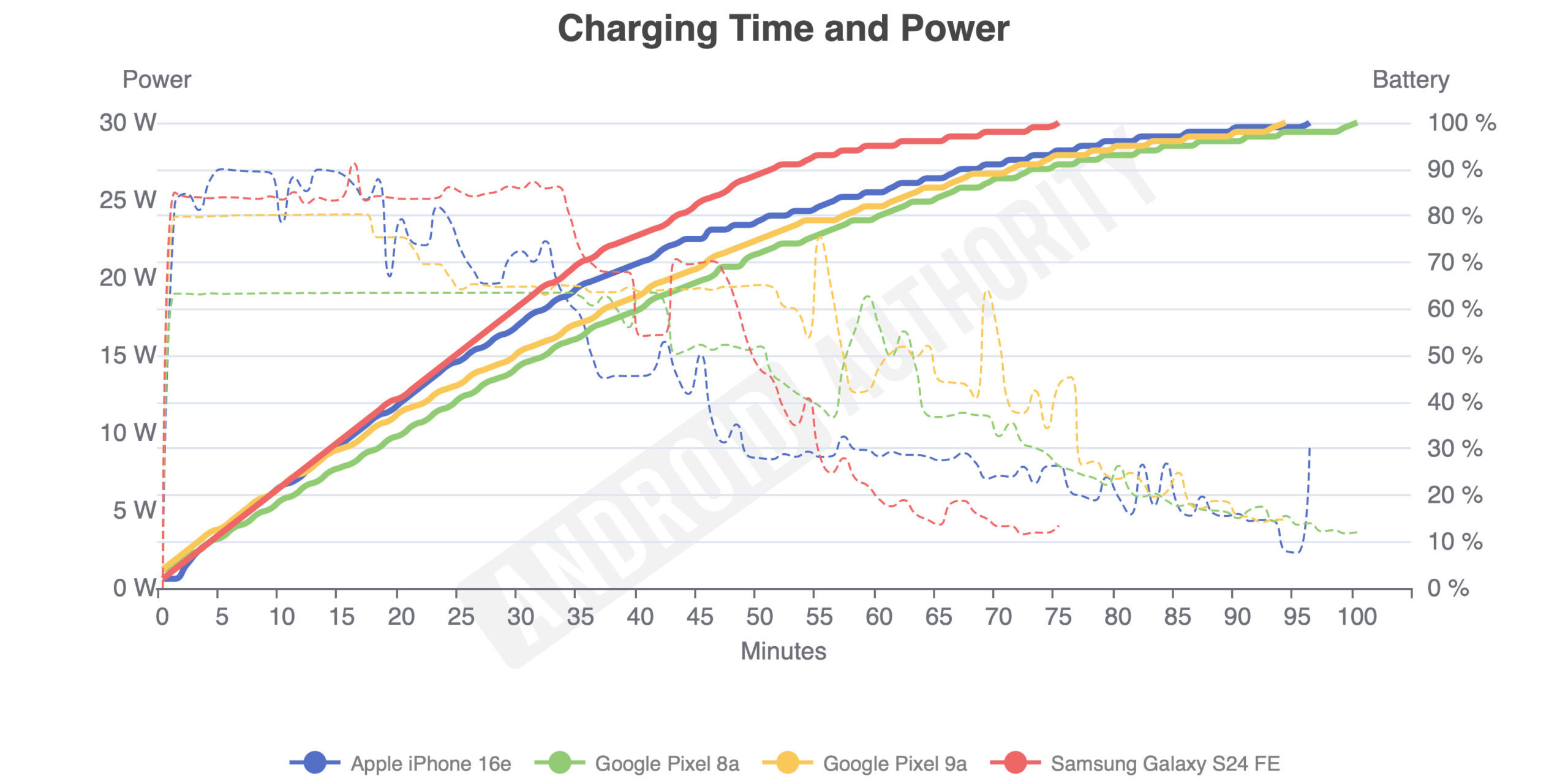
Ryan Haines / Android Authority
Interestingly, when I plugged my Pixel 9a in to measure its charging speed, it peaked at 25W before dipping back to 18W, presumably to balance its thermals, so I suppose 23W is roughly the average limit rather than the absolute one. Either way, the bump in maximum charging speed meant that the Pixel 9a was a hair quicker to all of our charging milestones (50% full, 75% full, and completely full) than its predecessor, despite having a significantly larger battery onboard. It wrapped up about 10 minutes ahead of the Pixel 8a and closer to five minutes faster than the iPhone 16e, though Google’s latest mid-ranger came nowhere close to the 75 minutes required by the Galaxy S24 FE.
If you’re less interested in wired charging, the Pixel 9a also supports 7.5W wireless charging. It’s not Qi2 certified or Qi2 Ready like the Galaxy S25 series, so your current charging pad should do just fine, so long as you don’t mind spending quite a lot more time with your phone tethered to a wall.
Google’s Pixel 9a cameras offer plenty of bang for my buck

Ryan Haines / Android Authority
And now, for the Pixel feature you’ve all been waiting for: The excellent cameras. The good news up front is that, yes, these are, indeed, Google Pixel cameras, which means they’re among the best around. They do everything you expect them to with the backing of the Tensor G4 chipset — they process images brilliantly, offer a simple, intuitive camera interface, and pack plenty of clever shooting modes for when you want more (sometimes a lot more) in your scene. Before we get to some camera samples from a few weeks of testing, though, we need to talk about exactly what Google has changed on the hardware front for its latest mid-range launch, because there are some clever tweaks in place.
First, Google swapped out the 64MP primary camera of its previous Pixel 8a for a new, slightly smaller 48MP primary camera with a wider maximum aperture of ƒ/1.7. It has a slightly wider focal length of 25mm to its predecessor’s 26mm, meaning that you’ll fit just a little bit more into your photos, but the more exciting change is that the Pixel 9a’s primary camera now provides its software-based macro mode. That means, unlike many budget phones that use their ultrawide cameras, the Pixel 9a’s macro shots have a larger sensor and less edge distortion to work with. Also, you can use macro mode with the camera set to 2x zoom, which might be the best part of this swap.
Macro mode on a primary sensor? It’s a better idea than I ever expected.
Of course, moving its macro mode around also means that the Pixel 9a’s ultrawide camera does just slightly less than before. It’s still a 13MP sensor and retains both the maximum aperture of ƒ/2.2 and 120-degree field of view, there’s just a little bit less for it to do the rest of the time. So, with that out of the way, let’s get to camera samples.
Based on this first row of samples, you might think I’m showing off how I escaped the dreary weather of early spring in Maryland, but that’s only partly true. In a more serious sense, I’ve simply taken so many photos around my hometown that I’m far more excited to show off something a little bit different, especially when the images come out like they did above. I’m particularly pleased with the shot to the far left, which captures plenty of detail through the stones in the foreground and the reflection in the mirror, yet it doesn’t try to blow out the interior of the building. Google’s performance in the full sun of the Mayan ruins is good, too, pairing sharp colors with more details in the stones.
Also, I love how the light bleeds through the trees on the far right, giving the higher levels of the jungle a bit of a glow but leaving the lower trees dark and slightly moody. I appreciate that Google didn’t try to brighten the scene beyond what I saw, as I think it would have tinted my memory just a bit.
Moving on, I featured a few of these images in my original Pixel 9a gallery, but I didn’t have time to dig into them all. I couldn’t tell you how much time I spent chasing lizards in Mexico, either trying to catch one or get a good photo, but I like the one I settled on. There’s just enough of a mix of white, sandy foreground and blue ocean in the background, and the relatively light shadows accurately reflect the weather of the day. I’ll also almost always feature a shot of my cats at home, as they’re one of the easier animals for me to photograph, especially when the sun hits just right on the chair in the corner of my room. I like how the sun falls across my cat’s fur, coloring the shades of black but mixing them nicely with the shadows.
Now, for Google’s modified macro mode, I’ve used a few of these samples before, but I wanted to point out one of the green buds in the middle. It took me longer than I’d like to admit that I could punch in to use macro mode at 2x zoom, which helps to further counteract the fisheye distortion that sometimes comes with ultrawide cameras. This let me hold my camera a little further away without sacrificing the details I picked up or the colors I recreated. I think 2x macro photos might be the new standard for me when it comes to close-up details.
Bumping out to the 13MP ultrawide camera, I’ll say that the Pixel 9a continues with its rock-solid performance. Although I’m usually hit or miss on the ultrawide look, I generally like the scale it’s given my subjects, making the Baltimore Aquarium, Patterson Park pagoda, and the interior space where my cousin had his cocktail hour look tall and imposing. There’s also no noticeable shift in color profile from the ultrawide shots to the primary camera, which is always a relief.
If there’s one weakness to the Pixel 9a’s dual camera setup, it’s the zoom capabilities. Maxing out at 8x zoom is already a pretty limited range, but it’s made worse because I don’t love the quality when punched all the way in. Although the first three shots look decent, and the field of view is probably my favorite at 2x zoom, some of the sharpness begins to go by the time I reach 8x zoom, especially in the rocks that make up the wall. The falloff isn’t as severe as it is on the iPhone 16e when you hit 10x zoom — I’d still share the shot above in an Instagram story if needed, it’s just not as good as I’d find with a dedicated telephoto sensor of any resolution.

Ryan Haines / Android Authority

Ryan Haines / Android Authority
On the other hand, the real reason to buy a Pixel is its mountain of clever shooting modes like the rebuilt panorama feature. The revamped way to capture panoramas was introduced on the Pixel 9 series, requiring you to move across a series of floating dots rather than following two parallel lines, and it’s just as good this time around. I spent plenty of time digging through both views above and only found one tiny spot where the Tensor G4 didn’t process things perfectly, which is pretty good considering that both shots are more than 180-degree views.
Panoramas aren’t the only clever trick up Google’s sleeve, as the Pixel 9a also supports other recent camera innovations like Add Me, Long Exposure, and editing tricks like Magic Editor. I don’t personally love to put that many edits into my photos, and I’d much rather have a stranger take my picture than try to line up a photo perfectly in Add Me, but I’m glad to see that neither feature got left on the cutting room floor with the extra RAM and Pixel Screenshots.
These are top-tier Google Pixel cameras, which means they’re among the best around.
On the video side, Google’s mid-ranger tops out with 4K quality at up to 60 frames per second or 1080p at up to 120 frames per second. I found that it was at its best in 4K at 30 frames per second, as I felt like the stabilization was more reliable, and I’m not usually capturing enough action to need those extra frames. Either way, you should have no issues with the stabilization or audio quality, as the Tensor G4 can once again be left to work some magic.
Also, if you want to check out full-resolution versions of the camera samples above — and many more — you can do so at this Google Drive link.
Verdict: The Google Pixel 9a might be all the phone most people need
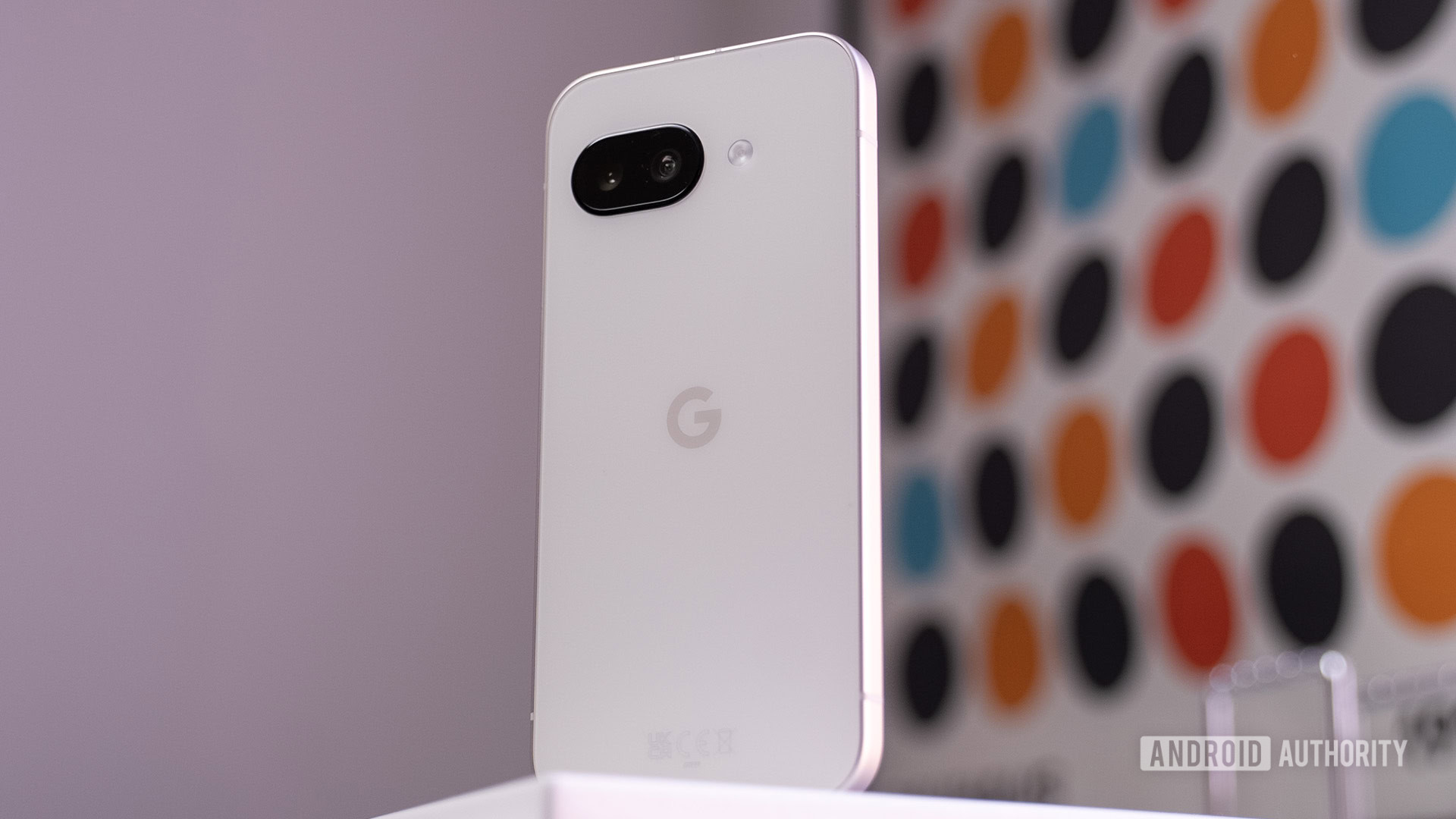
Paul Jones / Android Authority
All told, Google’s Pixel 9a doesn’t sound like it should be as good as it is. It’s not quite the best performer in the mid-range segment, nor does it have the biggest display or the most flexible cameras. It doesn’t use the most premium of materials, though Google’s mix of aluminum and Gorilla Glass 3 does just fine. And yet, when you look at what it does well and what it costs, it’s easy to see how the Pixel 9a feels like a stroke of brilliance. To me, it’s just enough of everything that I need at just the right price.
I mean, Google’s bumped-up battery gives the Pixel 9a legs to run past its closest competitors, and the promise of seven years of software updates adds reliable longevity right on into the 2030s. I prefer Google’s Pixel UI experience to either One UI or iOS anyway, even as the latter shifts closer and closer to Android with each passing update. And, of course, it’s hard to argue with the way that the Tensor G4 chipset continues to process images and videos with the best of them. Whether or not I’m tired of Google’s true-to-life color science, I know I can trust the image I get when I press the shutter button, even if I edit it later.
Google’s Pixel 9a offers the perfect mix of performance and price that makes it oh, so easy to recommend.
Perhaps the most crucial thing the Pixel 9a gets right, however, is its price. At just $499, this phone feels like a steal. It’s a full $100 cheaper than Apple’s closest competitor, the iPhone 16e, and it starts at $150 more affordable than Samsung’s Galaxy S24 FE. And sure, you might prefer Samsung’s slightly more flexible cameras thanks to the added telephoto lens, or you might find that Apple’s increasingly customizable iOS experience is right up your alley, but I think that the Pixel 9a strikes the perfect level of balance between the two while putting less of a strain on your wallet than either one.
Then again, you may decide that Google’s latest mid-range Pixel isn’t for you. After all, I spent time with the Galaxy S24 FE ($552.54 at Amazon) and iPhone 16e ($599 at eBay) and found much to like about them. With the former, I was especially impressed with Samsung’s granular customization, letting me explore every aspect of One UI until my head spun. It’s also a faster charger than its mid-range rivals, saving as many as 20 minutes over the Pixel 9a when plugged in. Of course, the real reason to reach for Samsung’s offering over something like the Pixel 9a is its camera flexibility. Google’s Super Res Zoom simply can’t compete with a 3x optical telephoto camera, even if it’s limited to a resolution of 8MP. Samsung also has the benefit of camera filters that make it easier to modify your image before you press the shutter rather than afterward. The other Samsung option you might consider waiting for is the Galaxy A56 5G, which will also retail for $499 when it eventually launches in the US (later this year, TBC), but based on the on paper comparison, I don’t think it’ll be much competition for Google’s A series.
As for the iPhone 16e, well, the gap between it and the Pixel 9a is a bit wider. Sure, you’ll be buying your way into Apple’s expansive ecosystem with perks like the A18 chipset and the growing list of Apple Intelligence features, but the iPhone 16e is more like a half-step into a modern device. Although it no longer looks and feels like an extremely dated iPhone 8 — thankfully — it settled somewhere around the design of an iPhone 12 with one rear camera rather than two. I quite like that Apple traded its mute switch for a programmable Action Button, and the long-term promise of years of iOS updates is great, but it’s hard to reach for a smaller, less flexible phone when it costs more than Google’s newest Pixel.
Also, while Apple and Samsung might represent the most natural threats to the popularity of a mid-range Pixel, they’re hardly the only competition. OnePlus has an option of its own in the OnePlus 13R ($599.99 at OnePlus), which is built closer to the specs of a 2024 flagship than a 2025 mid-ranger. It carries Qualcomm’s excellent Snapdragon 8 Gen 3 chipset under the hood and pairs it with 12GB of RAM — four more than the Pixel 9a offers, if you’ll remember. The OnePlus 13R also has the largest display of the group at 6.78 inches, the fastest wired charging (80W, along with a charger in the box), and a convenient 50MP telephoto sensor that allows you to jump comfortably beyond the Pixel 9a’s maximum of 8x zoom.
And yet, there’s one more option waiting for buyers at this mid-range price point — deciding whether or not to buy a 2024 (or early 2025) flagship instead. While the Pixel 9a is really good for the money, it’s not hard to find a discount on the Pixel 9 ($799 at Amazon) or a Samsung option like the Galaxy S25 ($809.99 at Amazon). Both offer a bump in materials and charging speed, similar update commitments, and slightly more capable cameras. I still think I’d lean towards the personality-packed Pixel 9 over the smallest of the Galaxy trio, but it all comes down to how close you can bring yourself to the Pixel 9a’s $499 price point.
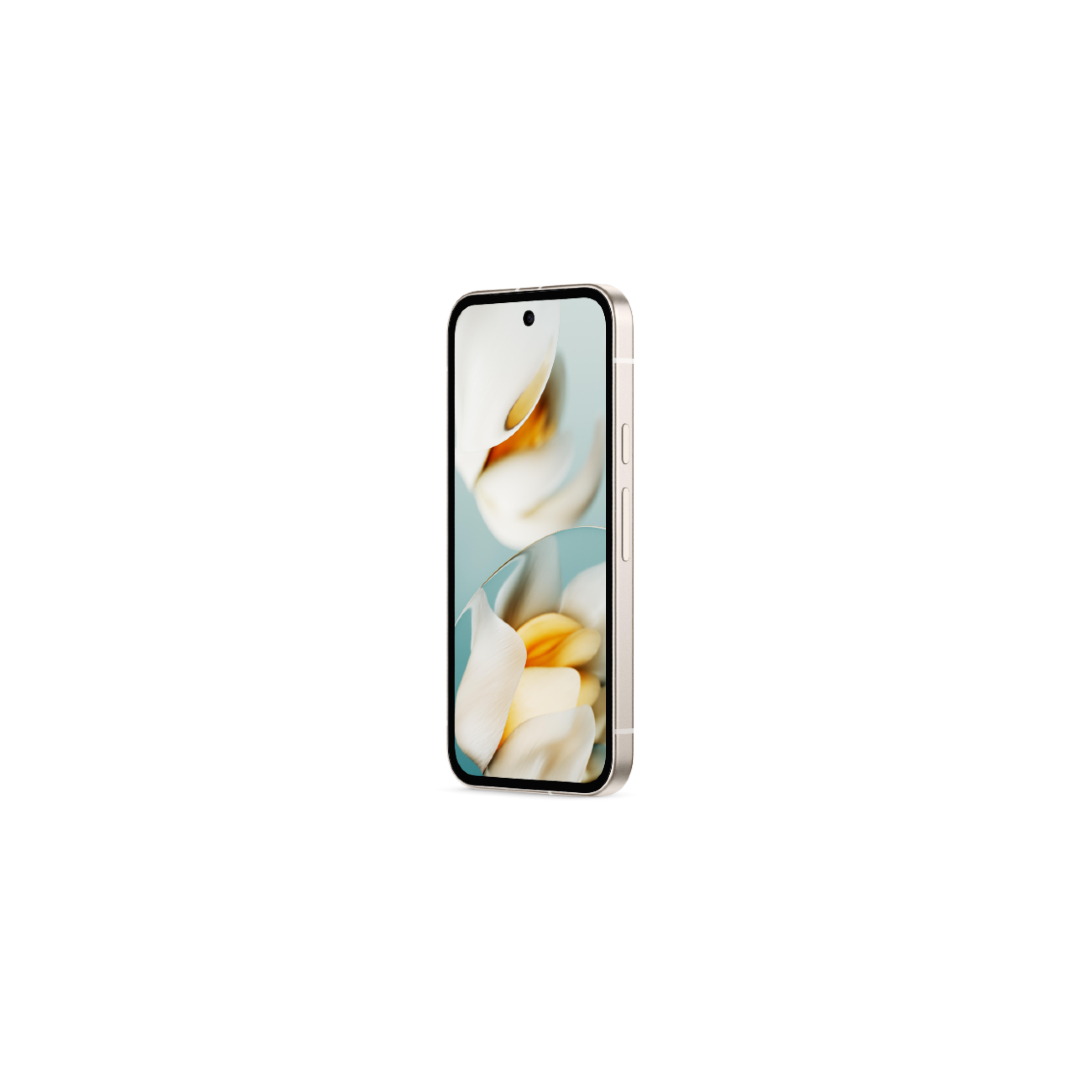
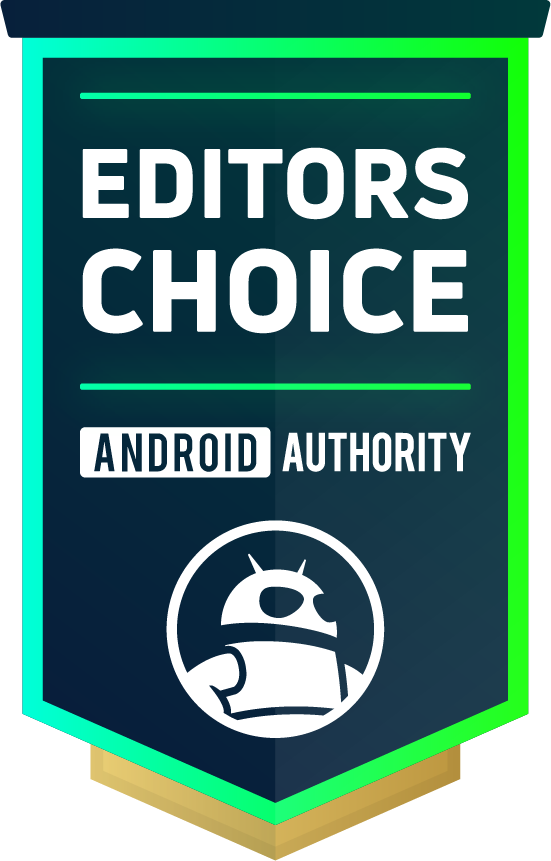
Google Pixel 9a
Built-in Gemini • Incredible camera • All-day battery
MSRP: $499.00
All the Pixel essentials for less.
The Google Pixel 9a brings built-in Gemini, an incredible camera, all-day battery, and seven years of updates for under $500.
Positives
- Solid, reliable cameras
- Excellent update commitment
- Clever AI-powered features
- Great battery life
- New, streamlined design
- Excellent price
Cons
- Relatively slow charging
- Aging Gorilla Glass 3 (again)
- Missing Pixel Screenshots

